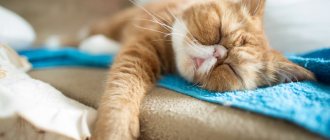A healthy cat with satisfactory maintenance and nutrition pees 3 to 5 times a day. Deviations from this norm may indicate an imbalance in water balance, which is easy to correct. To do this, you need to provide the animal with unhindered access to water at any time of the day.
However, there are accompanying signs that indicate the development of pathologies of the genitourinary system. They lead to difficulty urinating. Every owner should know about these symptoms in order to pay attention in time and provide competent assistance to the pet.
Norms of urination in cats and cats
The number of urinations per day in adult cats and female cats may vary slightly. This is due to the difference in the structure of the genitourinary organs of males and females. Due to the longer and narrower urethra, cats need to pee 3 to 5 times a day.
While cats need 2-3 times a day. This multiplicity does not depend on previous sterilization or castration, so any deviations from the norm should be perceived by the owner as an alarming signal.
Associated symptoms of urinary retention
Untimely urine flow can be very dangerous for a cat's life. Due to urinary retention, the body is at risk of intoxication, and the bladder may simply not withstand the strain. The following symptoms indicate urinary retention:
- plaintive meowing while going to the toilet;
- a sudden change in the smell, consistency or color of urine;
- strong thirst;
- loss of appetite;
- restless behavior;
- temperature increase;
- the appearance of pus, blood or other inclusions in the tray;
- frequent licking of the genitals;
- weakness;
- pain and tension of the abdomen on palpation;
- prolonged and unsuccessful attempts to pee;
- tucking or, conversely, unusual stretching of the hind limbs;
- reluctance to sit in the owner's arms.
The appearance of several symptoms of urinary retention in a kitten is a reason for a mandatory visit to a doctor in order to make a diagnosis and prescribe the necessary treatment.
Why can't my cat pee?
The reasons why the cat was unable to go to the litter box may be external factors. Usually, after eliminating them at home, the process of urination returns to normal without medical intervention.
These factors include:
- insufficient water consumption;
- prolonged stay in a hot room or outdoors in the summer;
- a sudden change in diet (transferring cats to dry ready-made food);
- moving to a different climate zone;
- stress;
- surgeries on the genitourinary system.
Sometimes a cat cannot pee for a long time after abdominal surgery on the abdominal organs or intestines. This is due to the fact that during the administration of general anesthesia, the animal involuntarily empties the bladder, and the slowdown of all vital processes in the body during anesthesia prevents it from filling quickly.
Important! If two days after castration the cat still cannot pee or the cat does not go to the toilet in a small way, then you should contact a veterinarian.
But there are also pathological reasons that a cat cannot go to the toilet in a small way, in which a person must help the pet.
Urolithiasis disease. This disease often develops in cats that do not receive adequate physical activity, and the basis of their diet is dry food.
When a cat doesn't drink enough and doesn't urinate enough, crystals begin to form in the kidneys, which gradually form into stones. At the first stage of the disease, the animal begins to frequently go to the toilet in small portions, since sand and larger stones constantly irritate the mucous membrane of the bladder and urethra. But at the moment when stones get into the ducts and block them completely, cats cannot go to the toilet in a small way. Urine accumulates in the bladder and, if left untreated, leads to rupture of its walls.
Important! Problems with urination and digestion in cats arise when the owner makes a serious mistake and begins to feed his pet both natural and ready-made food. The imbalance of such a diet also often leads to allergic reactions, hair loss, eczema and other skin diseases.
Cystitis. Inflammatory processes in the bladder in cats and cats in the first phase of development provoke frequent urination and pets can go to the toilet a little every hour. But if left untreated, the disease enters the second phase, in which swelling of the urinary canal prevents the outflow of fluid and the cat cannot pee.
You should not treat cystitis in cats on your own, since the pathology that is not completely cured will constantly manifest itself in relapses. You should also find out the reasons for the development of the disease and its type.
The fact is that the struvite-induced form of cystitis is a harbinger of urolithiasis. Inappropriate treatment in this case will provide temporary relief, but will subsequently lead to the cat being unable to pee due to kidney stones.
Note! Experts identify an idiopathic form of cystitis, which presumably occurs against the background of severe stress. Therefore, if after a stressful situation the cat does not go to the toilet, you should urgently contact a veterinary clinic.
Anomalies of the development of the genitourinary apparatus in cats. Sometimes this pathology manifests itself in the first months of an animal’s life, when the kitten does not go to the toilet very often or the process causes difficulties for him. But there are cases where manifestations of congenital anomalies are observed in pets in adulthood.
At first, the cat begins to rarely go to the toilet in small ways without pain. But hypothermia or bacterial infections can trigger inflammatory swelling, which leads to a lack of urination for 2 or more days.
The reason that cats urinate little may be prostatitis. In the acute form of the disease, there is no full urination, but droplets of bloody discharge appear from the urethra, the animal’s posture indicates severe pain in the abdominal area.
In the chronic form, the cat does not go to the toilet very well, but does not show signs of anxiety.
Important! The risk of developing urolithiasis and other pathologies of the genitourinary system in cats increases after sterilization. Therefore, if a neutered cat cannot pee in the toilet, you should immediately visit a veterinary clinic for catheterization.
Treatment and prevention
The doctor will tell the owner after the examination how to treat the pet and how to reduce painful symptoms. But it is much wiser not to treat the pathology, but to try to prevent its occurrence.
Proper nutrition is good disease prevention
To do this, it is recommended to remember and adhere to the following recommendations:
- Regardless of the age and condition of the animal, it is recommended to take it to the veterinarian for a preventive examination once every six months;
- The owner needs to monitor the weight of the animal and at the first signs of obesity, immediately put the cat on a diet. This is due to the fact that excess weight increases the load on internal organs and provokes a malfunction of the body’s systems;
- no matter what food the cat eats, industrial or natural, it should always have clean and fresh water;
- It is necessary to exclude salt, smoked meats, marinades, and sausages from your pet’s diet.
If the animal often walks outside, during the winter season the owner is advised to limit the time of such walks, since hypothermia also negatively affects the pet’s condition.
The main signs of the disease
The main sign that a cat cannot pee is when the animal walks around the tray and meows pitifully. Some owners notice that their pets sometimes behave in this way during heat. But you should distinguish between these reasons in order to promptly help a cat who cannot go to the toilet in a small way at home.
A sick pet exhibits the following clinical signs:
- depressed state;
- unnatural posture with an arched back, a bent neck and knees pushed forward;
- enlargement of the abdomen due to a full bladder;
- decreased or lack of appetite;
- increased body temperature;
- plaintive meowing or screaming during sudden attacks of pain.
If the cat begins to pee a little, then you should pay attention to the quality of the urine. It may change from a light yellow color to an orange or brown tint due to the presence of blood cells. Also, the urine will emit an unpleasant purulent odor, and its structure will become grainy due to crystalline inclusions or sand.
Note! Sometimes a sign that your cat can't pee is stretching out its back legs and licking the genital area for a long time. Also, if it is painful for a cat to go to the toilet in a small way, he lies down near the tray and meows pitifully, demonstrating his problem to the owner.
Pathogenesis
Various variants of pathogenetic processes lead to impaired urination and urine retention.
The essence of mechanical ischuria (the most common type of pathology) is the fact of a barrier in the lower part of the urinary ducts. Phimosis, the release of stones from the bladder cavity, and prostate pathologies can block the passage of urine. Obstructions in the form of blood clots appear after surgical interventions in the bladder area or urethral bleeding.
In most cases, ischuria progresses slowly. The exception is the passage of a stone or blood clot - then delay and pain during urination occurs suddenly and sharply. This often happens at the time of urination and is accompanied by severe pain.
The pathogenesis of impaired urine outflow caused by dysfunction of the urinary ducts is more complex: in this situation, the fluid cannot come out not because of obstacles, but because the bladder has lost the ability to contract normally. Neurological and stress disorders lead to disruption of the opening of the urethral sphincter or suppress natural reflexes - this gives rise to ischuria.
What to do at home if your cat can't pee
The first thing to do if your cat cannot go to the toilet is to take him to the clinic. The doctor will be able to quickly assess the danger of the situation and take radical measures to alleviate the animal’s condition.
First aid
But sometimes circumstances develop in such a way that it is not possible to quickly bring your pet to the hospital. In this case, you should know what to do and how to provide first aid at home to a cat who cannot pee.
To relieve spasm and relax the smooth muscles of the ureters and bladder, male cats should be given an intramuscular injection of No-shpa or Papaverine.
Important! If a cat rarely goes to the toilet or has completely absent urination for more than a day, then giving diuretics is strictly prohibited.
If the cat cannot pee, then as therapy at home you can treat it with Cat Erwin, and also inject it with an antibacterial drug (Tsiprolet, Baytril).
This will help relieve spasm and reduce inflammation for a short period of time. This period should be used to take the cat to the clinic or call a veterinarian at home.
Important! You shouldn’t try to do something on your own if the cat hasn’t been able to pee for 2 days or is screaming in pain or won’t let you touch her belly. In this case, only immediate catheterization can save her from death.
Veterinarian actions
After examining the cat and making a preliminary diagnosis, the veterinarian carries out treatment. It can be roughly divided into 4 stages:
- Preventing stretching and rupture of the bladder in a cat or cat that has not gone to the toilet for more than two days. To do this, a soft catheter with an attached closed system for collecting urine is inserted into the animal. For sterilized cats that periodically cannot pee after castration, a temporary catheter is placed. This is necessary to reduce the risk of developing ascending bacterial infections.
- Stimulation of the bladder muscles. The most effective drug for this is Bethanechol. However, multiple side effects and the need for urgent administration of an antidote in case of intolerance make it possible to use it only in a hospital setting, under the strict supervision of a physician. Cisapride and Propanolol are considered safer drugs for cats. But their independent administration is also prohibited.
- Decreased tone of the urethra and bladder neck. If the obstruction is not associated with anatomical developmental abnormalities, then a cat who has stopped peeing and does not recover for a long time after catheterization is prescribed muscle relaxants (Acepromazine, Diazepam) and alpha-adrenergic antagonists (Phenoxybenzamine, Prazosin).
- Prevention of the development or relief of infectious processes in the lower urinary tract. They often cause systemic inflammation, which can be fatal. Therefore, a veterinarian must prescribe antibacterial drugs to a cat that has not gone to the toilet for the second day or more than 2 days.
Note! The optimal way to select antibiotics is to conduct a preliminary bacteriological study of urine to determine the sensitivity of pathogenic microorganisms to certain drugs. In this case, you can achieve effective results and spend less time treating a cat that cannot pee.
Treatment options
At home, it is impossible to diagnose and carry out full effective treatment for a cat that cannot pee in the litter box on its own. This is due to the fact that in addition to conservative methods of therapy, surgical intervention is often used to eliminate this syndrome.
The most common indications for surgery in cats are malignant and benign tissue growths, as well as urolithiasis. A somewhat less common reason for performing surgery on a cat that rarely goes to the toilet is anatomical anomalies in the structure of the organs of the genitourinary system.
Diagnostics
When contacting a veterinary clinic to determine the causes of urinary retention, the doctor will definitely carry out the following manipulations:
- Visual inspection. When examining a kitten's abdomen, the veterinarian will certainly notice a full and painful bladder. When pressing on it, urine usually does not come out. If urinary retention has been observed for a long time, an examination may reveal symptoms of kidney damage: the smell of ammonia from the breath, decreased capillary refill rate, hypothermia, decreased heart rate. Also, cats may have a swollen genital organ due to constant trauma from licking.
- Ultrasound of the bladder usually reveals its fullness and the presence of suspension in it. Kittens also undergo an ultrasound of the kidneys to exclude their involvement in the inflammatory process.
- An X-ray of the abdominal organs is performed to find out how much damage the kitten's kidneys and urinary system have suffered.
- Biochemical and clinical blood tests show the condition of the liver and the level of intoxication in the body.
- A clinical urine test is necessary to detect bacteria and traces of blood in it.
- Sometimes cats are given an ECG to detect the toxic effects of high potassium levels on the heart muscle.
Special diet
After establishing the reason why the cat cannot pee and carrying out treatment, you should make the right choice of ready-made cat food or change the diet from natural products.
Among industrial cat foods, preference should be given to holistic ones. But the high cost and difficulties in purchasing sometimes become an obstacle for owners. Therefore, they can be replaced with super premium food.
Important! Sometimes owners have a hard time getting their pets to switch to holistic. This is due to the lack of flavor enhancers and flavoring agents that are added to lower class feeds.
In case of urolithiasis, the diet of cats that eat natural food should be adjusted depending on the type of stones. To do this, you need to consult a veterinary nutritionist or attending physician, who will base his recommendations on laboratory data.
| Type of stones | Authorized Products | Prohibited Products |
| Phosphates | rice, buckwheat, oatmeal; | whole milk; |
| boiled beef and rabbit; | hard and fermented milk cheese; | |
| boiled liver | Fish and seafood | |
| Oxolates | boiled carrots, cauliflower; | offal; |
| boiled dietary meat | Fish and seafood; | |
| milk | ||
| Urats | allowed boiled vegetables; | meat and fish broths; |
| lamb, duck, non-lean beef | offal; | |
| lean meat; | ||
| asparagus; | ||
| cauliflower; | ||
| legumes |
For any type of stone, cats can be given pureed baked apples and pears.
How to avoid diseases of the genitourinary system?
It is necessary to understand that once you have received such an illness, you will not be able to get rid of it completely. Only preventive measures and regular veterinary examinations will help your cat lead a comfortable lifestyle. To prevent difficulty urinating, you need to follow a few tips:
- Vaccinate your cat on time to reduce the risk of various diseases. Thanks to which fewer microorganisms will penetrate his body.
- The animal must not be allowed to become hypothermic. Do not allow your pet to lie on concrete or cold floors.
- You should give your cat something to drink as often as possible, since drinking large amounts of liquid flushes out its bladder. In this case, the water must be clean and fresh.
- In order to prevent recurrence of inflammation of the genitourinary organs, you need to properly formulate your diet. Completely prohibited products should be excluded from it.
- You need to play with the animal more often. In addition, the cat should run at least 30 minutes a day. Movement will help prevent the occurrence of many diseases.
And remember that giving medications and treating ailments that have led to difficulty urinating in your beloved pet is putting his health and even life in danger . If such problems arise, you should seek help from specialists as quickly as possible. In addition, do not forget to vaccinate your cat.











